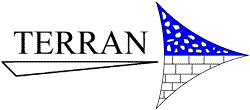Heather Marsh
Dodson-Lindbloom Associates
4052 Dublin Rd., Columbus, OH 43221
Amy D. Lamborg and Mark J. Howell
Terran Corporation
4080 Executive Dr., Beavercreek, OH 45430
The excavation of a large-diameter tunnel has provided a fresh and unique look at the Columbus Limestone in Franklin County, Ohio. Variations in the geologic character of the bedrock, such as the occurrence of solution cavities, fracture zones, and high-permeability areas are of the utmost importance during tunneling.
The tunnel ranges from 129 to 114 inches in diameter, is 50 to 90 feet below ground surface, and from 0 to 85 feet below the top of the bedrock. It is over 6 miles long, and trends north-south in the vicinity of Dublin Road in Columbus.
The tunnel passes through numerous singular and distributed solution features including open and infilled fractures, cavities and bedding planes. Dimensions of the solution features can range from a few inches to more than 240 feet wide. Some of these karst features are filled with a red, black or white clayey material. These materials have occurred separately, completely intermixed, or as clasts within each other. A sample of the red material was determined to be gibbsite, which has not been described in Ohio previously. A sample of the white material contained highly crystalline illite and the mineralogy of the black material has yet to be determined. The karst features also variously contained well sorted fine or coarse sand, wood fragments, gravels, shale fragments and a 1.5 cm thick layer of chalk. Some features are a major source of water infiltration into the tunnel, with possible initial heading inflows of 500 gpm, possibly ranging up to 1000 gpm.
During tunneling, lineaments were mapped along the tunnel corridor using aerial photographs and topographic maps. A number of these features were encountered during tunneling. In the subsurface, these lineaments proved to be fractures, although not all of those with surface expression had been widened by solutioning.
This paper was presented at the Geological Society of America Section Meeting, Columbus, OH, March 19-20, 1998.
